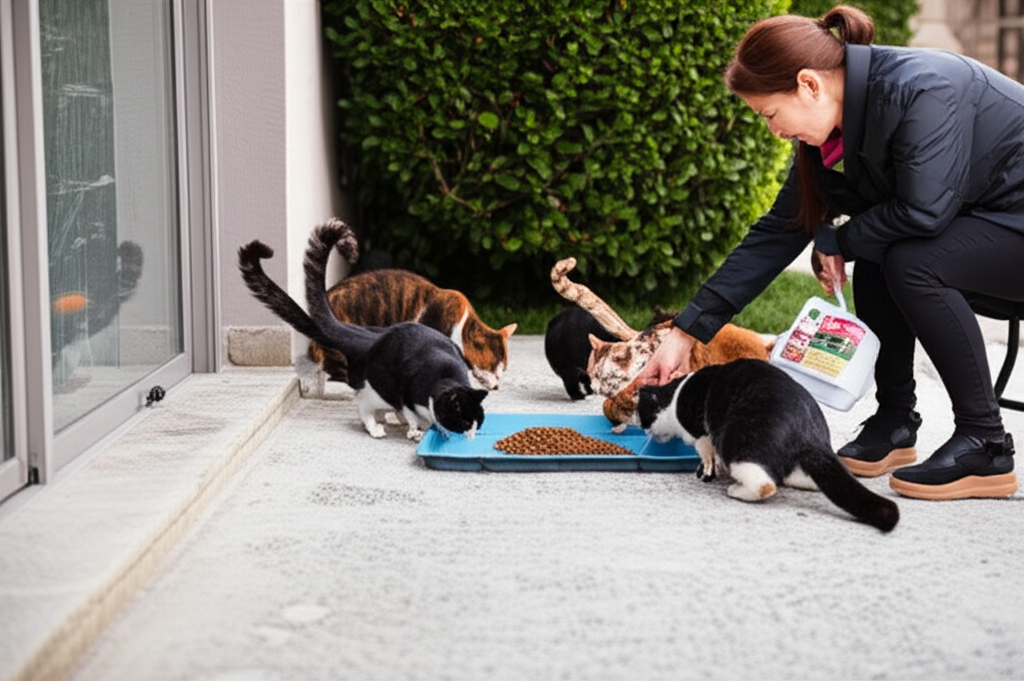
Feeding Stray Cats: Best Practices and Common Mistakes
The right way to provide food for homeless cats without creating dependency or other issues.
Feeding stray and community cats is one of the most common ways people help homeless felines. While the intention is compassionate, how you provide food can significantly impact both the cats' welfare and your relationship with your community. Proper feeding practices help cats stay healthy while minimizing potential conflicts with neighbors and local wildlife.
In this guide, we'll explore evidence-based best practices for feeding stray cats, common mistakes to avoid, and how to address concerns that might arise from your feeding activities. Whether you're caring for a single stray or managing a larger colony, these guidelines will help you provide care responsibly.
In this article:
Nutritional Needs of Outdoor Cats
Stray and community cats have different nutritional requirements than indoor pets. Their active outdoor lifestyle and exposure to the elements mean they need more calories, especially during cold weather.
Key Nutritional Considerations:
- Higher calorie needs: Outdoor cats can require up to 2-3 times more calories than indoor cats, especially in winter
- Protein requirements: High-quality protein is essential for maintaining muscle mass and immune function
- Fat content: Healthy fats provide concentrated energy and help maintain body temperature
- Water: Access to fresh water is just as important as food, even in cold weather
Recommended Foods:
Dry Food (Kibble)
Pros: Cost-effective, convenient, doesn't freeze in cold weather, can be left out longer
Cons: Lower moisture content, may not be as palatable to some cats
Recommendation: Choose a high-quality, high-protein kibble specifically formulated for active or outdoor cats. Look for options with at least 30% protein.
Wet Food
Pros: High moisture content, highly palatable, easier for cats with dental issues
Cons: More expensive, freezes in cold weather, attracts insects, must be removed promptly
Recommendation: Use as a supplement to dry food, especially during extreme cold when cats need extra calories. Remove uneaten portions after 30 minutes.
Veterinary Insight: "In my practice, I've seen many well-meaning people feed inappropriate foods to stray cats. While cats might eat almost anything when hungry, foods like milk, raw fish, or dog food don't provide the right nutrition and can cause health problems. Stick with commercial cat food formulated for their specific needs." — Dr. James Lee
Best Practices for Feeding Stations
How and where you set up feeding stations can significantly impact both the cats' safety and your relationship with neighbors. A well-designed feeding station minimizes mess, deters wildlife, and helps cats feel secure while eating.
Ideal Feeding Station Features:
- Elevation: Raised platforms keep food dry and reduce access by other animals
- Weather protection: Overhead cover prevents rain and snow from spoiling food
- Visibility: Clear sightlines allow cats to watch for threats while eating
- Multiple exits: Prevents cats from feeling trapped
- Discreet location: Somewhat hidden from street view but accessible to cats
- Cleanable surfaces: Materials that can be easily sanitized
An ideal feeding station with elevation and weather protection
DIY Feeding Station Ideas:
Plastic Bin Shelter
Cut entrance holes in a plastic storage container, place food and water inside. Add a removable lid for easy cleaning. Cost: $10-15.
Modified Doghouse
Repurpose a small doghouse with an entrance hole and feeding platforms inside. Provides excellent weather protection. Cost: $30-50.
Feeding Table
Create a simple elevated platform with a roof. Easy for multiple cats to access simultaneously. Cost: $20-40 in materials.
Pro Tip: "After years of colony management, I've found that using automatic feeders with timers can be a game-changer. They dispense a set amount of food at specific times, which helps maintain a feeding schedule even when you can't be there. This prevents food from sitting out all day and helps condition cats to come at certain times." — Colony Manager Rebecca T.
Feeding Schedules and Amounts
Establishing a consistent feeding routine helps cats know when to expect food and prevents them from wandering in search of other food sources. It also allows you to monitor which cats are coming to eat and notice if any are missing or ill.
Recommended Feeding Approaches:
Scheduled Feeding (Recommended)
Food is provided at specific times each day and removed after cats have eaten.
Benefits:
- Allows monitoring of which cats are eating
- Reduces wildlife attraction
- Prevents food spoilage
- Helps establish a routine for TNR efforts
Recommendation: Feed once or twice daily at consistent times, allowing 30-60 minutes for cats to eat before removing leftover food.
Free Feeding (Less Ideal)
Food is left out continuously for cats to access at any time.
Drawbacks:
- Attracts wildlife and insects
- Food can spoil or become contaminated
- Difficult to monitor individual cats' intake
- Can lead to neighborhood complaints
If necessary: Use only dry food in limited amounts and check daily to refill and clean the area.
How Much to Feed:
The amount of food needed depends on several factors, including the number of cats, their size, the climate, and whether they have other food sources. As a general guideline:
- Adult cat (average size): ½ to ¾ cup of dry food per day
- During cold weather: Increase by 25-50%
- For a colony: Start with ½ cup per cat and adjust based on observation
Monitor how much food is being eaten and adjust accordingly. If all food is consistently gone within minutes, you may need to provide more. If there's always food left over, reduce the amount to prevent waste and wildlife attraction.
Seasonal Considerations: "During winter months, I feed my colony cats a higher-calorie diet with more fat content. I also provide slightly larger portions since they burn more calories staying warm. In summer, I make sure to provide extra water sources and feed earlier in the morning or later in the evening when it's cooler." — Colony Caretaker Michael P.
Common Mistakes to Avoid
Even with the best intentions, there are several common feeding practices that can create problems for both the cats and the community. Avoiding these mistakes will help ensure your feeding efforts are beneficial and sustainable.
Mistake #1: Feeding inappropriate foods
Problem: Items like milk, raw meat, or table scraps can cause digestive issues and don't provide balanced nutrition.
Solution: Stick to commercial cat food formulated specifically for cats. If you want to provide treats occasionally, use small amounts of plain cooked chicken or commercially prepared cat treats.
Mistake #2: Leaving out too much food
Problem: Excess food attracts wildlife like raccoons, opossums, and rodents, which can lead to community complaints and potential disease transmission.
Solution: Provide only what cats will eat in one sitting and remove leftovers. Monitor and adjust portions based on actual consumption.
Mistake #3: Feeding on the ground
Problem: Ground feeding creates mess, attracts insects and wildlife, and exposes food to contamination.
Solution: Use elevated feeding stations with washable dishes that are cleaned regularly. This keeps food cleaner and reduces access by non-target animals.
Mistake #4: Inconsistent feeding times
Problem: Irregular feeding causes stress for cats and may lead them to seek food elsewhere, potentially creating nuisance behaviors.
Solution: Establish a consistent schedule that cats can rely on. If you can't maintain the schedule, consider finding a backup feeder or using automatic feeders.
Mistake #5: Feeding without spay/neuter
Problem: Feeding without addressing reproduction leads to population growth and increased suffering.
Solution: Implement or support TNR (Trap-Neuter-Return) efforts for any cats you feed. This humanely reduces the population over time while improving the health of the cats.
Common Misconception: "Many people believe that feeding stray cats will make them dependent and unable to hunt. In reality, most stray and feral cats retain their hunting abilities even when fed regularly. Providing food actually helps reduce predation on wildlife by reducing hunger-driven hunting, while ensuring cats have consistent nutrition." — Wildlife Biologist Dr. Sarah M.
Addressing Community Concerns
Feeding stray cats can sometimes lead to concerns from neighbors or local authorities. Addressing these proactively helps maintain good community relations and ensures you can continue caring for the cats.
Common Concerns and Solutions:
Concern: Attracting wildlife or pests
Solution: Use timed feedings, remove uneaten food promptly, keep feeding areas clean, and use elevated feeding stations. Consider motion-activated deterrents for unwanted wildlife.
Concern: Cats using gardens as litter boxes
Solution: Provide a designated outdoor litter area near feeding stations using sand or loose soil. Suggest cat-deterrent plants or materials for concerned neighbors' gardens.
Concern: Noise from cat fighting or mating
Solution: Support TNR efforts to reduce mating behaviors and territorial disputes. Spayed/neutered cats are typically quieter and less aggressive.
Concern: Local ordinances against feeding
Solution: Research local laws and work with animal advocacy groups to understand exemptions or to advocate for TNR-friendly policies. In some areas, registered colony caretakers are exempt from feeding bans.
Building Community Support:
- Educate neighbors about the benefits of TNR and managed feeding
- Keep feeding areas tidy and inconspicuous
- Respond promptly to any concerns
- Offer to help with deterrents if cats are causing specific problems
- Connect with local TNR groups for additional resources and support
- Document your colony management efforts to demonstrate responsibility
Success Story: "When I started feeding the colony behind my apartment building, several neighbors complained to management. Instead of stopping, I invited concerned residents to meet me at feeding time. I explained TNR, showed them my clean feeding station, and introduced them to the cats. Several neighbors ended up becoming supporters, with one even volunteering to feed when I'm away. Open communication made all the difference." — Colony Caretaker Lisa J.
Key Takeaways
- Feed appropriate commercial cat food that meets outdoor cats' nutritional needs
- Create elevated, protected feeding stations that minimize mess and wildlife access
- Establish consistent feeding schedules and remove uneaten food
- Combine feeding with TNR efforts for humane population management
- Address community concerns proactively through education and responsible practices
- Adjust feeding practices seasonally to accommodate changing needs
- Keep feeding areas clean and maintain good relationships with neighbors

Dr. James Lee
Veterinarian
Dr. James Lee is a veterinarian with over 15 years of experience specializing in feline health. He volunteers with several TNR programs and regularly provides care for community cat colonies. Dr. Lee has published research on the nutritional needs of outdoor cats and conducts workshops for colony caretakers on best feeding practices.
Related Articles
Want more care tips for community cats?
Subscribe to our newsletter for seasonal advice and resources.


